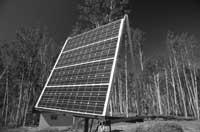Cleaner solar energy
The solar panels, among other things, convert the energy of the Sun into electricity. Neal R. University of Arizona The work done by scientist Armstrong can become an important step in the use of solar energy. It has a very fine organic membrane capable of assembling spontaneously. This membrane is formed by organic molecules, which although at first it is in liquid state, is capable of acquiring the condition of photovoltaic cells.
The work of scientists consists in designing, synthesizing and characterizing the most appropriate molecules for the functions of photovoltaic cells. From their liquid state, these molecules must be able to assemble them until they form a layer of at least 100 nanometers that allows them to transport electricity.

If the film was effective, solar panels of very flexible material could be constructed at the base, such as those that are collected and placed as paper rolls that are used for the walls, and more importantly, cheap of fabrication.According to Armstrong, the efficiency of this type of plates is such that the conversion of electricity is economic.
Currently, in the solar energy market, 99% of the photovoltaic panels are based on silicon. Silicon is a good, reliable and effective material, but quite expensive. Silicon solar panels are used in many fields, for example in space research, but their high price makes the solar energy sector unable to advance. In the United States, for example, if they had to pay the dollar for every kW/h produced in conventional systems, they would have to pay three times more for the same amount as photovoltaic systems, although solar energy was much more expensive. Other European countries, such as Germany, pay more for the electricity obtained from renewable sources.
However, prices are being matched, reducing differences. Studies such as the organic membrane can provoke a greater approximation of both markets. In addition to silicon, research has been carried out with other inorganic materials that, despite being more efficient and economical than silicon, can be very harmful to the environment.
In this sense, it is evident that organic systems are less toxic than others. Research on these systems began in the 1970s of the last century. Then, its effectiveness reached exactly 1.5%, so research did not entail large investments. However, an investigation has been carried out as complete as possible, being one of the results one of the organic membranes of the University of Arizona. The membrane that is currently being designed can absorb almost entirely the solar spectrum and, it seems, can have a close efficiency of 20%.





